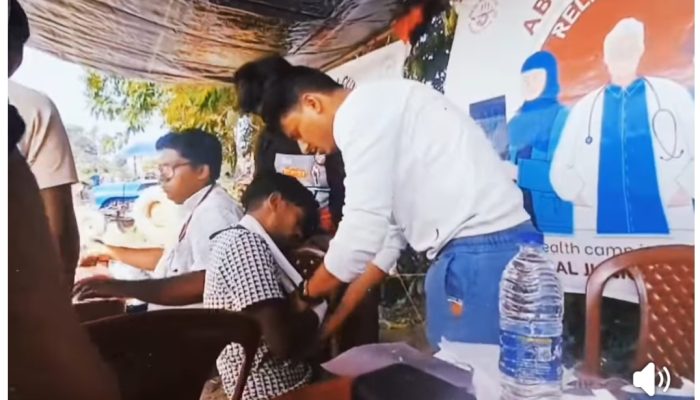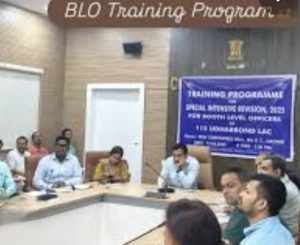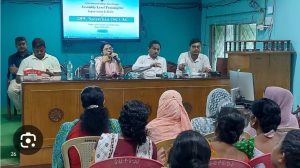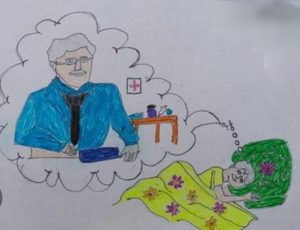প্রাইমারি ডিজাস্টার রেসপন্স হিসেবে বন্যা ও ভূমিধ্বসে বিধ্বস্ত উত্তরবঙ্গের বিস্তীর্ণ অঞ্চলে সপ্তাহব্যাপী অভয়া স্বাস্থ্য শিবিরের বিভিন্ন অভিজ্ঞতা আমরা এক এক করে সকলের সাথে ভাগ করে নিতে চাই।
বন্যাবিধ্বস্ত ডুয়ার্স থেকে ধ্বসে বিধ্বস্ত পাহাড়ের বিভিন্ন এলাকায় স্বাস্থ্যশিবিরের ধারাবাহিকতার একখণ্ড গল্প। রঙমুক এলাকার সিডার্স চা বাগান। ধ্বস মেরামত করে চলাচলের রাস্তা খুলেছে সবে, বেশ কিছু জায়গা এখনও বিপজ্জনক ভাবে ভাঙা। অভয়া ক্লিনিকের আয়োজন হল সেই চা বাগানের পাশে, চন্দামানধুরা গ্রামে। এই বন্ধ চা বাগান অঞ্চলের মানুষের অর্থনৈতিক অবস্থা ভীষণ অনিশ্চিত, অনেকেই প্রতিদিন বেঁচে থাকার লড়াই চালিয়ে যাচ্ছেন।
চিকিৎসা শিবিরে একে একে আসছিলেন এলাকার মানুষ– কেউ জ্বর, কেউ পেটের সমস্যা, আঘাত লাগা, সর্দিকাশি নিয়ে, কেউ আবার শুধু নিজেদের অবস্থার কথাগুলো বলতে চেয়েছেন, বিপর্যয়ের অভিঘাত বাসিন্দাদের মানসিক স্বাস্থ্যকেও বিপর্যস্ত করেছে। এমন সময় স্থানীয় উদ্যোক্তারা জানালেন, কিছুটা দূরে গ্রামের ভেতরে বৃদ্ধ ও শয্যাশায়ী কয়েকজন এর স্বাস্থ্য পরীক্ষার প্রয়োজন আছে, যাঁরা ধ্বসের পর থেকে ঘরেই আটকে আছেন। তখন আমাদের টিমের একাংশ বেরিয়ে পড়ে মোবাইল ক্লিনিক হিসেবে, ভাঙা রাস্তা আর পাহাড়ি ঢাল পেরিয়ে পৌঁছতে তাঁদের কাছে।
পথে চোখে পড়ল ধ্বসের গভীর দাগ। কোথাও রাস্তা নেই, কোথাও গাছের গোড়া গিয়ে ঠেকেছে ঘরের ছাদে। স্থানীয়রা বলছিলেন, যে পাড়াটা ধ্বসে গেছে, সেখানে এখন আর কিছুই বাকি নেই। পুরো গ্রামকেই নতুন জায়গায় স্থানান্তর করতে হবে, সরকারি পুনর্বাসনই একমাত্র পথ।
যতটা সম্ভব আমরা এই পরিস্থিতি নথিভুক্ত করার চেষ্টা করেছি। এখানকার মানুষের সঙ্গে নিয়মিত যোগাযোগ রাখব, জানতে যে সরকার তাঁদের এই পুনর্বাসনের দাবি মেনে কী কী উদ্যোগ নিচ্ছে, আর সেই প্রতিশ্রুতিগুলো বাস্তবে কতটা রূপ পাচ্ছে।
Field Diary । North Bengal Disaster Response Medical Camps by the West Bengal Junior Doctors’ Front ।
As part of our primary disaster response, the West Bengal Junior Doctors’ Front set up week-long medical camps across the flood and landslide-hit regions of North Bengal. From the waterlogged plains of the Dooars to the shattered slopes of the hills, each camp carried its own story of struggle, resilience, and hope.
One chapter unfolded in Rangmuk, near the Cedars Tea Garden. The road had just been cleared after days of repair, but many stretches still remained treacherous. Our camp took shape beside the garden, in Chandamandhura village, a community reeling from the closure of the tea estate where survival itself is a daily fight.
Villagers arrived steadily, some with fever, stomach problems, injuries, or persistent coughs, and others simply to share their experiences. The emotional toll of the disaster was evident, and mental health distress was everywhere. Soon, locals mentioned that a few elderly and bedridden residents, trapped indoors since the landslides, needed urgent attention. A team from our camp set out as a mobile clinic, maneuvering broken roads and steep slopes to reach them.
On the way, the scars of the landslides were impossible to ignore. Roads had disappeared, tree roots clung to rooftops, and entire patches of land had collapsed. At one destroyed hamlet, locals said, “There’s nothing left there anymore.” Relocation to safer areas seemed inevitable, and government-led rehabilitation appeared to be the only viable solution.
We tried to document as much as possible, capturing both the physical devastation and the human stories. In the days ahead, we will keep in close touch with the affected families to monitor how the government addresses their rehabilitation and whether its promises translate into real change.
#wbjdf #abhayaclinic #NorthBengal













